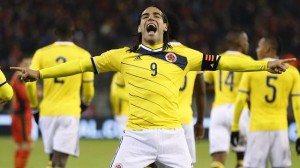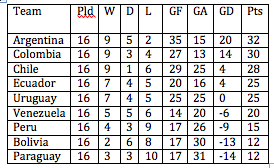Radamel Falcao. Photo Cred: Reuters
Corruption. Drug Cartels. Football. Murder. Escobar. Throughout its history (see this post on Colombian Soccer History [1]), Colombian soccer has been ensconced in the middle of one of the most ruthless and violent South American environments, helplessly acquiring a venal stereotype. Colombian players would play soccer against drug kingpin Pablo Escobar in his government-built luxury prison [2], and many club teams were speculated to be run by drug money. Moreover, Colombia’s football accomplishments had always been overshadowed by its maniacal reactions to defeat. After not advancing past the group stage in the 1990 World Cup, the Colombian national team was unyielding in its desire to achieve relevancy, beating an Argentina squad 5-0 that was undefeated for the previous 30 games and earning a number one seed in the 1994 World Cup as well as Pele’s pick to win the World Cup [1]. Yet after a disappointing opening match to Romania in the first game, Colombian fans began to panic not only for the success of their team, but also for the safety of their favorite players.
Pablo Escobar. Photo Cred: AP Photo
Before a critical second match against the United States in 1994, Colombian coach Francisco Maturana and halfback Gabriel Gomez were subjected to death threats of “There will be bombs in your house and in Gomez’s house if you put him on the field” [1]. Fearing for their lives, Maturana withheld Gomez from the game, yet star forward Faustino Aspirilla recounted that “This is what was on our minds as we went on to the pitch – that, if we didn’t win, there would be trouble and we would be killed” [1]. The players were no longer playing for their country or for the love of the game but rather for their lives, a fight they were not fated to win.
The match against the United States is one of the most famous matches in World Cup history, as fan favorite Andres Escobar scored an own goal in the 35th minute in one of the most unlikely and disheartening plays you could ever watch.
Colombia suffered defeat at the hands of the United States, and despite a win in their next match, were eliminated from the World Cup. Tragedy struck just one week later, as Andres Escobar, one of the most beloved players in the history of Colombian soccer, was murdered after exiting a club in Medellin for what many believe was vengeance for scoring the own goal. ESPN Films 30 for 30 has a sensational documentary on The Two Escobars (Pablo and Andres) that could describe the scene and what followed better than I ever could, so I would encourage you to take the time to watch this incredible film.
https://www.youtube.com/watch?v=6EilV9vgaEY
This incident drew international attention to the atrocities and deep-rooted corruption of Colombian soccer, which once again brought Colombia into the international spotlight.
But that was 1994. Now, the Colombian national football team is ranked 4th in the world by FIFA and has clinched its first World Cup berth in 16 years (Colombia also did not make it past the first round after failing to qualify behind Romania and England in the 1998 World Cup [3]). And though the expectation and excitement surrounding the team parallels that of 1994, the state of Colombia has much improved since then. Since 2002, Colombia has taken a step forward by regaining territories once lost to rebels and cartels in the North and East [4]. Moreover, Farc, the largest rebel group, began to negotiate with the Colombian government in November of 2012 [4]. Yet, although only 6% of the country is now under political threat from terrorist groups [4], Colombia is still not a safe place to travel to as cartels and drug lords continue to play a significant role in society.
The restoration of Colombia has been rocky over the past decade, and fittingly, the resurgence of Colombian soccer has also not been without its bumps and bruises. Despite the promise and talent of strikers Teófilo Gutiérrez and Radamel Falcao (Colombian Player to Watch), the Colombian national football team got off to a shaky start in its World Cup qualification (WCQ) matches.
In its first qualifying match back in 2011, Colombia found themselves up early on Bolivia after a goal by Dorlan Pabon, yet conceded a late goal to Bolivia’s Walter Flores in the 85th minute [5]. Interestingly, despite scoring 34 goals for FC Porto in the 2009-2010 season and knotting 36 goals for Atletico Madrid in the 2011-2012 season [6], Radamel Falcao did not earn a starting position on the national team. Yet in the 78th minute, Falcao was substituted for Gutiérrez amidst cheers and support from the fans and scored in the 90th (+2) minute to propel Colombia to a 2-1 opening WCQ win against Bolivia [5]. This victory, however, was not at all convincing and foreshadowed the impending struggles the team would face.
Just over a month later, Colombia played its first WCQ match at home against a much weaker Venezuela squad. And despite scoring the game-winning goal a month before, Falcao was once again a spectator for the match as he saw his team concede another late goal to earn a disappointing draw against Venezuela [7]. Still, Colombia had the opportunity to put this win behind them as a match against top ranked Argentina loomed in just 4 days.
Colombia’s first WCQ match against Argentina was played at home and was the match everybody around South America wanted to see. Was Colombia all it was ramped up to be, or would it fall at the hands of the soccer elite? To their jubilation, Colombian fans were able to rejoice as Dorlan Pabon netted a goal just before halftime to give Colombia a 1-0 lead [8]. Colombia was dominant on attack, forcing several scoring opportunities in the first half, yet it was two different teams that emerged from the locker room after halftime. Colombia, a once steadfast, accurate team, could not record shots on goal and struggled to merely complete a pass as Lionel Messi and Sergio Aguero came out strong in the second half. Messi soon did what he does better than anyone in the world and evened the game at 1-1 in the 60th minute [8]. Yet Colombia was not dilapidated, as they were presented with an opportunity to reclaim the lead when Camilo Zuniga was robbed point blank by Argentinean goaltender Sergio Romero. And in what seemed like déjà vu, Colombia once again conceded another late goal in the 83rd minute after Messi created a magnificent set-up through which Aguero was able to score on the rebound [8]. Falcao watched from the sideline as his team suffered defeat, thus earning just 4 points in its first 3 games.
Fans began to panic as their beloved Colombia squad seemed far from the successful team they had been assured of over the past few years. Moreover, this mediocre start drew criticism towards coach Leonel Alvarez, as many disparaged him for not placing their star, Radamel Falcao, in the starting line-up [9]. There seemed to be some animosity of Alvarez towards Falcao, as Alvarez asserted that Falcao wasn’t as successful on the international level as he was with Atletico Madrid [9]. Yet after this disappointing start, changes needed to be made, and José Pékerman, the Argentinean national coach from 2004-2006, took over in January of 2012 [9]. While some questioned the move, Colombia captain Mario Yepes simply explained, “Pekerman isn’t so well known in Europe because he’s only ever coached in South America” and praised “…his desire to play really polished and technical football” [10]. Furthermore, Pekerman was not akin to Alvarez’s belief that Falcao could not succeed on the international level, as Falcao immediately became a routine starter. And wherever Falcao went, success followed. Colombia went 5-1 in its next 6 games under Pekerman [11], outscoring opponents 15-2 over that span and beating notable teams such as Uruguay and Chile 4-0 and 3-1, respectively. And in June of 2013, Colombia marked on their calendar the rematch against Argentina.
Colombian coach José Pékerman. Photo Cred: EQ Images.
After losing at home 1-2 against Argentina, Colombia was motivated to walk away from Argentina with points and consequently shuffled their line-up, replacing Macnelly Torres with Teófilo Gutiérrez to partner with Falcao [12]. Yet no one could have predicted what transpired so early on as Christian Zapata and Gonzalo Higuaín were both sent off with red cards early on after a heavily criticized refereeing decision [13]. Nevertheless, with space opening up, a more attacking style of play was expected, yet the referee’s decision actually seemed to take the life out of the game, as both sides were content to play it safe. However, in the 72nd minute, Aguero took a close range shot that was called back after a controversial offside call that earned Colombia a satisfying 0-0 draw at Argentina [13].
In its next two home matches against Peru and Ecuador, Colombia earned two convincing victories and could smell a much-needed, if not more-deserved World Cup Qualification [11]. They needed just a draw at Uruguay, a team they had beaten back in September of 2012 by a convincing four goals to zero [11]. Yet with a team that is so strong up front, trying to sit back and relax was not an effective strategy for Colombia, as they lost 2-0 without having any real scoring chances [14]. Nevertheless, this loss was not treated as Colombia’s inferiority but rather as an anxiousness of being so close to competing in a tournament they were denied from for 16 years.
And unfortunately, it seemed as though this hangover would continue. In their next match at home against Chile on November 10, they once again resorted to this casual style of play and quickly saw themselves down 3-0 at halftime after Juventus star Arturo Vidal and Barcelona play maker Alexis Sanchez came out strong for Chile [15]. But after halftime, Pekerman woke his team up as Gutiérrez scored a goal in the 69th minute and Falcao scored two penalty kicks in the 75th and 84th minutes [15].
http://www.youtube.com/watch?v=p5LXdKIAokg
And just like that, Colombia punched its ticket to the 2014 World Cup in Brazil with a 3-3 draw against Chile, finishing second behind Argentina with 30 points in 16 qualification matches.
South American Qualification Table
Colombia is a team on a mission, a team destined to overcome its harrowed past. Pekerman’s decision to start Falcao has made the Colombian attack one of the most feared groups in the world, with Falcao netting 9 goals in 13 games in the South American qualifier [9]. Moreover, with a brilliantly skilled midfielder in James Rodriguez, Colombia displays a confident, cohesive team that can take on anybody in the world. As mentioned above, they are 4th in the FIFA rankings behind only Spain, Germany, and Argentina. They have been praised for their ability to simply outscore their opponents, yet the strength of their defense is definitely underestimated. Behind Yepes, Luis Amaranto Perea, and goalie David Ospina, Colombia conceded just 13 goals throughout the World Cup qualifiers, a mark which proved the best in South America [9]! On December 6th, Colombia was drawn into a soft Group C with Greece, Côte d’Ivoire, and Japan, so I would look for them to make it past the group stage and potentially to the semi-finals. Colombia has shown that its greatest weakness is getting off its game and attempting to exhibit a more relaxed style of play which it is ill suited toward. Nevertheless, the comeback against Chile demonstrated a fiery resilience, and the fact that the team has gone on to beat Belgium and tie the Netherlands in two away friendly matches after already qualifying for the World Cup shows that this team is not going to let its pedal off the gas [16]. As fans, we can only hope that Colombia can try to replace names like Pablo Escobar and Gonzalo Gacha with names like Radamel Falcao and Teófilo Gutiérrez and truly show the world how far it has come.
Click here to return to the Qualifying Stories Home Page
References:
[1] Ginn, Courtney. “Colombia.” The Politics of Football in Latin America, Soccer Politics Blog. Duke University. 2009. Accessed: 5 Dec. 2013. http://sites.duke.edu/wcwp/research-projects/politics-and-sport-in-latin-america/columbia/.
[2] Reilly, Rick. “Playing soccer with Pablo Escobar.” ESPN.com. 22 May 2012. Accessed: 2 Dec. 2013. http://espn.go.com/espn/story/_/id/7958914/playing-soccer-pablo-escobar?src=mobile.
[3] “1998 World Cup France.” FIFA.com. Accessed: 3 Dec. 2013. http://www.fifa.com/worldcup/archive/edition=1013/results/index.html.
[4] “Colombia profile.” BBC. 16 July 2013. Accessed: 8 Dec. 2013. http://www.bbc.co.uk/news/world-latin-america-19390026.
[5] “Bolivia vs Colombia Lineups and Statistics.” goal.com. Accessed: 4 Dec. 2013. http://www.goal.com/en-us/match/64283/bolivia-vs-colombia/lineup-stats?ICID=CP_213.
[6] Ness A, Reintgen M, Di Sant Albano AB, Yoo J, Rape A, Doria G, Tamizhmani K, Berezo M, Ochs M, Leachman, C & Al-Khalil R. “Colombia: Radamel Falcao.” Players to Watch at the 2014 World Cup, World Cup 2014, Soccer Politics Blog. Duke University. Dec. 2013. Accessed: 2 Dec. 2013. http://sites.duke.edu/wcwp/world-cup-2014/players-to-watch-at-the-2014-world-cup/conmebol/radamel-falcao/.
[7] “Colombia vs Venezuela Lineups and Statistics.” goal.com. Accessed: 4 Dec. 2013. http://www.goal.com/en-us/match/64287/colombia-vs-venezuela/lineup-stats?ICID=CP_212.
[8] Edwards, Daniel. “Colombia vs Argentina Report.” goal.com. Nov. 2011. Accessed: 3 Dec. 2013. http://www.goal.com/en-us/match/64289/colombia-vs-argentina/report?ICID=OP.
[9] Reuters. “Country profile: Colombia.” eurosport.com. 5 Dec. 2013. Accessed: 6 Dec. 2013. http://au.eurosport.com/football/world-cup/2014/factbox-colombia-world-cup-draw-factbox_sto4023745/story.shtml.
[10] ESPNsoccernet staff. “Yepes: Pekerman right for Colombia.” espnfc.com. 28 Feb. 2012. Accessed: 4 Dec. 2013. http://espnfc.com/news/story/_/id/1028394/mario-yepes:-jose-pekerman-right-man-for-colombia?cc=5901.
[11] “Qualifiers: Colombia.” FIFA.com. Accessed: 2 Dec. 2013. http://www.fifa.com/worldcup/preliminaries/southamerica/matches/team=43926/index.html.
[12] Edwards, Daniel. “Argentina vs Colombia Preview.” goal.com. Jun. 2013. Accessed: 5 Dec. 2013. http://www.goal.com/en-us/match/97314/argentina-vs-colombia/preview.
[13] Webber, Tom. “Argentina vs Colombia Report. goal.com. Jun. 2013. Accessed: 5 Dec. 2013. http://www.goal.com/en-us/match/97314/argentina-vs-colombia/report?ICID=OP.
[14] “FIFA World Cup Qualifying: Uruguay 2 Colombia 0.” soccerway.com. 10 Sep. 2013. Accessed: 5 Dec. 2013. http://us.soccerway.com/news/2013/September/11/fifa-world-cup-qualifying-uruguay-2-colombia-0/.
[15] PA Sport. “Falcao brace sends Colombia through.” espnfc.com. 11 Oct. 2013. Accessed: 5 Dec. 2013. http://espnfc.com/news/story/_/id/1580876/conmebol-falcao-brace-sends-colombia-through?cc=5901.
[16] “Colombia Fixtures & Results – 2013.” espnfc.com. Accessed: 8 Dec. 2013. http://espnfc.com/team/fixtures?id=208&cc=5901.
How to cite this article: “Colombia,” Written by Colby Shanafelt (2013), World Cup 2014, Soccer Politics Blog, Duke University, http://sites.duke.edu/wcwp/world-cup-2014/stories-from-the-2014-qualifiers/colombia/ (accessed on (date)).
Edited and Updated by Davis Muthoka in 2015.




